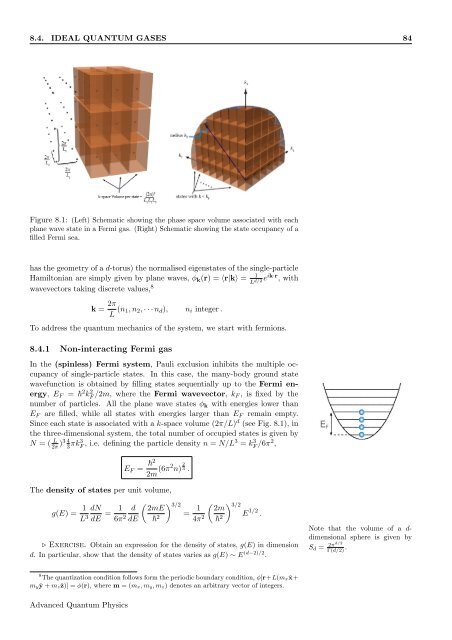Identical Particles - Theory of Condensed Matter
Identical Particles - Theory of Condensed Matter
Identical Particles - Theory of Condensed Matter
You also want an ePaper? Increase the reach of your titles
YUMPU automatically turns print PDFs into web optimized ePapers that Google loves.
8.4. IDEAL QUANTUM GASES 84<br />
Figure 8.1: (Left) Schematic showing the phase space volume associated with each<br />
plane wave state in a Fermi gas. (Right) Schematic showing the state occupancy <strong>of</strong> a<br />
filled Fermi sea.<br />
has the geometry <strong>of</strong> a d-torus) the normalised eigenstates <strong>of</strong> the single-particle<br />
Hamiltonian are simply given by plane waves, φk(r) =〈r|k〉 = 1<br />
L d/2 e ik·r , with<br />
wavevectors taking discrete values, 8<br />
k = 2π<br />
L (n1,n2, · · · nd), ni integer .<br />
To address the quantum mechanics <strong>of</strong> the system, we start with fermions.<br />
8.4.1 Non-interacting Fermi gas<br />
In the (spinless) Fermi system, Pauli exclusion inhibits the multiple occupancy<br />
<strong>of</strong> single-particle states. In this case, the many-body ground state<br />
wavefunction is obtained by filling states sequentially up to the Fermi energy,<br />
EF = 2 k 2 F /2m, where the Fermi wavevector, kF , is fixed by the<br />
number <strong>of</strong> particles. All the plane wave states φk with energies lower than<br />
EF are filled, while all states with energies larger than EF remain empty.<br />
Since each state is associated with a k-space volume (2π/L) d (see Fig. 8.1), in<br />
the three-dimensional system, the total number <strong>of</strong> occupied states is given by<br />
N =( L 4<br />
2π<br />
)3<br />
3πk3 F , i.e. defining the particle density n = N/L3 = k3 F /6π2 ,<br />
EF = 2<br />
2m (6π2 n) 2<br />
3 .<br />
The density <strong>of</strong> states per unit volume,<br />
g(E) = 1<br />
L3 dN<br />
dE<br />
1<br />
=<br />
6π2 d<br />
dE<br />
2mE<br />
2<br />
3/2<br />
= 1<br />
4π 2<br />
<br />
2m<br />
2 3/2 E 1/2 .<br />
⊲ Exercise. Obtain an expression for the density <strong>of</strong> states, g(E) in dimension<br />
d. In particular, show that the density <strong>of</strong> states varies as g(E) ∼ E (d−2)/2 .<br />
8 The quantization condition follows form the periodic boundary condition, φ[r+L(mxˆx+<br />
my ˆy + mzˆz)] = φ(r), where m =(mx,my,mz) denotes an arbitrary vector <strong>of</strong> integers.<br />
Advanced Quantum Physics<br />
Note that the volume <strong>of</strong> a ddimensional<br />
sphere is given by<br />
Sd = 2πd/2<br />
Γ(d/2) .

















